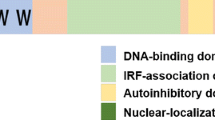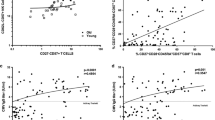Abstract
Polycomb group (PcG) proteins, which are conserved from invertebrates to mammals, are associated with epigenetic regulation of many cell fates. The activities of PcG proteins are largely associated with modulation of specific immune reactions. However, no study has attempted to explore the role of Phc2, a subunit of polycomb repressive complex 1, on helper T (Th) cell activation. Presently, Phc2 expression was down-regulated in activated Th cells. The ectopic expression of Phc2 in Th cells inhibited Th cell proliferation and secretion of interleukin-2 from Th cells upon antigen-specific activation. Phc2 may act as a negative regulator that inhibits the activity of Th cells.





Similar content being viewed by others
References
Abbas A. K.; Murphy K. M.; Sher A. Functional diversity of helper T lymphocytes. Nature 383: 787–793; 1996.
Akasaka T.; Tsuji K.; Kawahira H.; Kanno M.; Harigaya K.; Hu L.; Ebihara Y.; Nakahata T.; Tetsu O.; Taniguchi M.; Koseki H. The role of mel-18, a mammalian polycomb group gene, during IL-7-dependent proliferation of lymphocyte precursors. Immunity 7: 135–146; 1997.
Barnden M. J.; Allison J.; Heath W. R.; Carbone F. R. Defective TCR expression in transgenic mice constructed using cDNA based α- and β-chain genes under the control of heterologous regulatory elements. Immunol. Cell Biol. 76: 34–40; 1998.
Bird A. DNA methylation patterns and epigenetic memory. Genes Dev. 16: 6–21; 2002.
Cao R.; Tsukada Y.; Zhang Y. Role of Bmi-1 and Ring1A in H2A ubiquitylation and Hox gene silencing. Mol. Cell 20: 845–854; 2005.
Cao R.; Zhang Y. The functions of E(Z)/EZH2-mediated methylation of lysine 27 in histone H3. Curr. Opin. Genet. Dev. 14: 155–164; 2004.
Hosokawa H.; Kimura M. Y.; Shinnakasu R.; Suzuki A.; Miki T.; Koseki H.; van Lohuizen M.; Yamashita M.; Nakayama T. Regulation of Th2 cell development by polycomb group gene bmi-1 through the stabilization of GATA3. J. Immunol. 177: 7656–7664; 2006.
Ishihara S.; Schwartz R. H. Changes at the activated IL-2 promoter causes sequential chromatin structural two-step binding of transcription factors. J. Immunol. 187: 3293–3299; 2011.
Isono K.; Fujimura Y.; Shinga J.; Yamaki M.; O-Wang J.; Takihara Y.; Murahashi Y.; Takada Y.; Mizutani-Koseki Y.; Koseki H. Mammalian polyhomeotic homologues Phc2 and Phc1 act in synergy to mediate polycomb repression of Hox genes. Mol. Cell. Biol.. 25: 6694–6706; 2005.
Katoh-Fukui Y.; Owaki A.; Toyama Y.; Kusaka M.; Shinohara Y.; Maekawa M.; Toshimori K.; Morohashi K. Mouse polycomb M33 is required for splenic vascular and adrenal gland formation through regulating Ad4BP/SF1 expression. Blood 106: 1612–1620; 2005.
Kimura M.; Koseki Y.; Yamashita M.; Watanabe N.; Shimizu C.; Katsumoto T.; Kitamura T.; Taniguchi M.; Koseki H.; Nakayama T. Regulation of Th2 cell differentiation by mel-18, a mammalian polycomb group gene. Immunity 15: 275–287; 2001.
Lee H. H.; Lee S. J.; Kim S.; Jeong S.; Na M.; Lee DM.; Cheon Y. P.; Lee K. H.; Choi I.; Chun T. Porcine testicular extract inhibits T cell proliferation by blocking cell cycle transition from G1 phase to S phase. Biotechnol. Lett. 34: 1225–1233; 2012.
Morey L.; Helin K. Polycomb group protein-mediated repression of transcription. Trends Biochem. Sci. 35: 323–332; 2010.
Park H. J.; Lee S. J.; Kim S. H.; Han J.; Bae J.; Kim S. J.; Park C. G.; Chun T. IL-10 inhibits the starvation induced autophagy in macrophages via class I phosphatidylinositol 3-kinase (PI3K) pathway. Mol. Immunol. 48: 720–727; 2011.
Sato T.; Endoh M.; Yoshida H.; Yasuo S.; Katsuno T.; Saito Y.; Isono K.; Koseki H. Mammalian polycomb complexes are required for Peyer’s patch development by regulating lymphoid cell proliferation. Gene 379: 166–174; 2006.
Sparmann A.; van Lohuizen M. Polycomb silencers control cell fate, development and cancer. Nat. Rev. Cancer 6: 846–856; 2006.
Taniuchi I.; Osato M.; Egawa T.; Sunshine M. J.; Bae S. C.; Komori T.; Ito Y.; Littman D. R. Differential requirements for Runx proteins in CD4 repression and epigenetic silencing during T lymphocyte development. Cell 111: 621–633; 2002.
Thomas R. M.; Gao L.; Wells A. D. Signals from CD28 induce stable epigenetic modification of the IL-2 promoter. J. Immunol. 174: 4639–4646; 2005.
Traveres L.; Dimitrova E.; Oxley D.; Webster J.; Poot R.; Demmers J.; Bezstarosti K.; Taylor S.; Ura H.; Koide H.; Wutz A.; Vidal M.; Elderkin S.; Brockdorff N. RYBP-PRC1 complexes mediate H2A ubiquitylation at polycomb target sites independently of PRC2 and H3K27me3. Cell 148: 664–678; 2012.
Acknowledgments
This research was supported by Basic Science Research Program through the National Research Foundation of Korea funded by the Ministry of Education, Science and Technology (2010-0023283). This work was also supported by Next-Generation BioGreen 21 program (No. PJ008089), Rural Development Administration, Republic of Korea.
Conflict of Interest
None
Author information
Authors and Affiliations
Corresponding author
Additional information
Editor: T. Okamoto
Rights and permissions
About this article
Cite this article
Cho, KW., Bae, J., Lee, S.J. et al. Expression pattern and functional role of Phc2 during activation of helper T cells after antigenic stimulation. In Vitro Cell.Dev.Biol.-Animal 49, 360–370 (2013). https://doi.org/10.1007/s11626-013-9618-0
Received:
Accepted:
Published:
Issue Date:
DOI: https://doi.org/10.1007/s11626-013-9618-0




